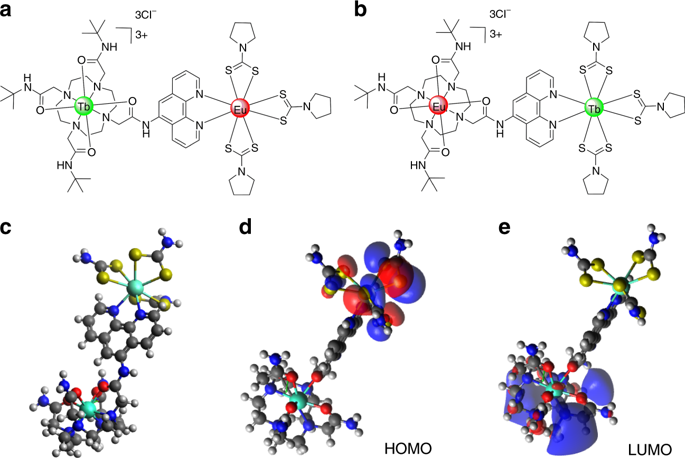当前位置:
X-MOL 学术
›
Light Sci. Appl.
›
论文详情
Our official English website, www.x-mol.net, welcomes your
feedback! (Note: you will need to create a separate account there.)
A stoichiometric terbium-europium dyad molecular thermometer: energy transfer properties.
Light: Science & Applications ( IF 20.6 ) Pub Date : 2018-01-01 , DOI: 10.1038/s41377-018-0097-7 Guochen Bao , Ka-Leung Wong , Dayong Jin , Peter A. Tanner
Light: Science & Applications ( IF 20.6 ) Pub Date : 2018-01-01 , DOI: 10.1038/s41377-018-0097-7 Guochen Bao , Ka-Leung Wong , Dayong Jin , Peter A. Tanner

|
The optical thermometer has shown great promise for use in the fields of aeronautical engineering, environmental monitoring and medical diagnosis. Self-referencing lanthanide thermo-probes distinguish themselves because of their accuracy, calibration, photostability, and temporal dimension of signal. However, the use of conventional lanthanide-doped materials is limited by their poor reproducibility, random distance between energy transfer pairs and interference by energy migration, thereby restricting their utility. Herein, a strategy for synthesizing hetero-dinuclear complexes that comprise chemically similar lanthanides is introduced in which a pair of thermosensitive dinuclear complexes, cycTb-phEu and cycEu-phTb, were synthesized. Their structures were geometrically optimized with an internuclear distance of approximately 10.6Å. The sensitive linear temperature-dependent luminescent intensity ratios of europium and terbium emission over a wide temperature range (50-298K and 10-200K, respectively) and their temporal dimension responses indicate that both dinuclear complexes can act as excellent self-referencing thermometers. The energy transfer from Tb3+ to Eu3+ is thermally activated, with the most important pathway involving the 7F1 Eu3+J-multiplet at room temperature. The energy transfer from the antenna to Eu3+ was simulated, and it was found that the most important ligand contributions to the rate come from transfers to the Eu3+ upper states rather than direct ligand-metal transfer to 5D1 or 5D0. As the first molecular-based thermometer with clear validation of the metal ratio and a fixed distance between the metal pairs, these dinuclear complexes can be used as new materials for temperature sensing and can provide a new platform for understanding the energy transfer between lanthanide ions.
中文翻译:

化学计量的-二联分子温度计:能量传递特性。
光学温度计已显示出在航空工程,环境监测和医学诊断领域的广阔前景。自引用镧系元素热探针因其准确性,校准,光稳定性和信号的时间维度而与众不同。然而,常规的掺杂镧系元素的材料的可再现性差,能量转移对之间的随机距离以及能量迁移的干扰限制了它们的使用,从而限制了它们的实用性。在本文中,引入了用于合成包含化学上相似的镧系元素的杂-核复合物的策略,其中合成了一对热敏性双核复合物cycTb-phEu和cycEu-phTb。它们的结构经过几何优化,核间距约为10.6Å。a和ter在宽温度范围内(分别为50-298K和10-200K)的灵敏线性温度依赖性发光强度比及其时间尺度响应表明,两种双核配合物均可作为出色的自参考温度计。来自Tb的能量转移3+到Eu 3+被热激活,最重要的途径是在室温下7 F 1 Eu 3+ J -multiplet。模拟了从天线到Eu 3+的能量转移,发现对速率最重要的配体贡献来自于向Eu 3+上层态的转移,而不是直接由配体-金属转移至5 D 1或5 D 0。作为第一个基于分子的温度计,其金属比和金属对之间的固定距离均得到明确验证,这些双核配合物可以用作温度感测的新材料,并且可以为了解镧系元素离子之间的能量转移提供新的平台。
更新日期:2019-01-26
中文翻译:

化学计量的-二联分子温度计:能量传递特性。
光学温度计已显示出在航空工程,环境监测和医学诊断领域的广阔前景。自引用镧系元素热探针因其准确性,校准,光稳定性和信号的时间维度而与众不同。然而,常规的掺杂镧系元素的材料的可再现性差,能量转移对之间的随机距离以及能量迁移的干扰限制了它们的使用,从而限制了它们的实用性。在本文中,引入了用于合成包含化学上相似的镧系元素的杂-核复合物的策略,其中合成了一对热敏性双核复合物cycTb-phEu和cycEu-phTb。它们的结构经过几何优化,核间距约为10.6Å。a和ter在宽温度范围内(分别为50-298K和10-200K)的灵敏线性温度依赖性发光强度比及其时间尺度响应表明,两种双核配合物均可作为出色的自参考温度计。来自Tb的能量转移3+到Eu 3+被热激活,最重要的途径是在室温下7 F 1 Eu 3+ J -multiplet。模拟了从天线到Eu 3+的能量转移,发现对速率最重要的配体贡献来自于向Eu 3+上层态的转移,而不是直接由配体-金属转移至5 D 1或5 D 0。作为第一个基于分子的温度计,其金属比和金属对之间的固定距离均得到明确验证,这些双核配合物可以用作温度感测的新材料,并且可以为了解镧系元素离子之间的能量转移提供新的平台。


















































 京公网安备 11010802027423号
京公网安备 11010802027423号